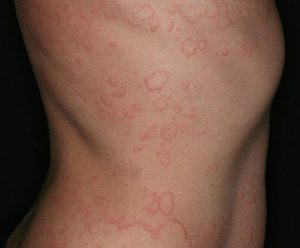When our immune system is exposed to something it considers dangerous or potentially dangerous, it tends to react in different ways. And depending on our genetic predisposition, this reaction can be exaggerated, resulting in what we know as an allergy. Among the many types that exist, skin allergies might be the most well-known and are undoubtedly the most common among people. Today’s article brings together all the information you need to better understand what skin allergies are and what they can cause.
What Are Skin Allergies?
We can define skin allergies as any type of reaction resulting from skin hypersensitivity that makes the immune system overreact to some external agent.As the skin is the largest organ in the human body, allergies can occur in virtually all areas of our body and at different stages of life. There are, for example, many types of allergy that are much more common in babies and children, such as atopic dermatitis. On the other hand, many are common at any age, such as contact dermatitis and angioedema.
Causes of Skin Allergies
The topic of skin allergies, as you may have noticed, is quite broad. This means that, while there are several types, each of them can have many different causes, which makes the list of possibilities quite extensive. However, there are some more common factors that can cause different types of skin allergies. The main ones are:
- Consumption of certain foods, especially shrimp, peanuts, and milk, which tend to cause allergies more easily
- Pollen
- Contact with certain chemicals
- Sweat
- Environments with very high or very low temperatures
- Insect bites
- Contact with mold
- Wearing costume jewelry
- Use of certain medications
- Certain types of soap
- Animal fur
As we have said, these are not the only causes of skin allergies, since it is an extensive topic. However, they are the main causes of the most common types and will certainly help you better understand how this type of allergy manifests.
Types of Skin Allergies
Since there are many skin allergies, it’s important to know at least the most common types, their characteristics, and how they manifest in our bodies. That’s why we’ve created a list to help you understand each of them in a bit more depth, which are:
- Contact Dermatitis
- Atopic Dermatitis
- Angioedema
- Urticaria (Hives)
Contact Dermatitis
Contact dermatitis, as its name suggests, is triggered when a person comes into contact with an allergic agent. Its main symptoms are redness and itching of the skin, and in more severe cases, there can be swelling, dryness, and blisters. In these situations, the treatment is aimed at relieving symptoms and avoiding contact with the agents so that the person does not have severe episodes again.
Atopic Dermatitis
Atopic dermatitis is a type of allergy that occurs in phases, with the most intense phase happening when contact with the triggering agent is more frequent. Among its main symptoms are also redness, itching, skin irritation, and even crusts that can ooze liquid in more severe cases. It is most common in babies during their first year of life, but can also appear in children and adults.Medication can help relieve symptoms, but doctors usually recommend ways to avoid contact with things that can trigger this type of allergy, such as soaps, shampoos, and even animals.
Angioedema
Angioedema is a type of allergy whose main characteristic is the swelling of thinner areas of the skin, such as the lips, scrotum, and eyes. It occurs due to dilation of the blood vessels in these areas, causing plasma fluid to leak into the extravascular tissue.When allergic, angioedema can result from a poisonous insect bite, certain medications, or even some type of food. Treatment is usually carried out quickly and, unlike most other skin allergies, it tends not to relapse so easily, unless exposure to such factors happens again.
Urticaria (Hives)
Usually caused by an allergic reaction to a certain food or medication, urticaria’s main symptoms are intense itching and redness of the skin, which can cause the well-known hives to appear, which are eruptions caused by scratching.There are many cases where the trigger for urticaria is unknown, causing it to appear and disappear spontaneously. Despite this, this type of allergy typically does not cause major complications.
Treatments for Skin Allergies
Treatment for each type of allergy can vary according to several factors, as skin allergies are diverse. These factors may include:
- The agent causing the allergy
- The type of skin allergy
- The stage of the allergy
In general, doctors may recommend corticosteroids or antihistamines to relieve symptoms. What is usually also done is the identification of the triggering agent, followed by recommendations for you to avoid contact with it and, consequently, prevent the allergy from reappearing.When we talk about skin allergies, the subject is truly vast. There are several types and also different ways they manifest. Still, it is important for us to learn more about this condition, especially to understand why they appear in our bodies and how we can treat them. Moreover, the most important thing is knowing how to prevent this type of allergy so that we can live more peacefully and without so many complications that may seem minor but can affect our lives in several ways.












